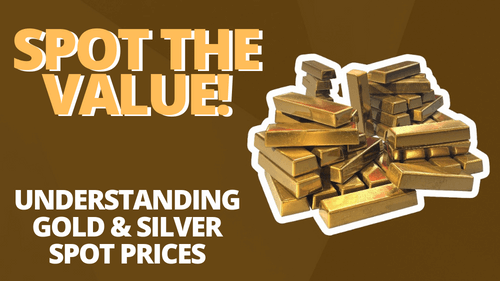June 24, 2019 | 5 Min Read
If there’s one thing we’ve learned in this business, it’s this - if something is valuable, there’s someone out there who will try to counterfeit it.
Watches. Purses. Sunglasses. You name it. If they can fake it, they will. This theory holds true with plenty of different types of merchandise, and we constantly see them brought through our shop.
The most common counterfeit item brought into our shop? Fake Gold.
Fake gold is brought into our store at least 2-3 times a day. Of course we don’t blame the customers. Most of the time the gold they are bringing in was sold to them as real. They got duped.
That’s why we created this quick guide to spotting fake gold. Now anyone can easily tell the difference between a real piece of gold jewelry, and a piece they should completely avoid.
How Do You Spot a Fake Piece of Gold?
Spotting fake gold can be a very simple process. We typically take 3 different steps to determine whether or not a piece of gold jewelry is fake. We’ve listed each of the 3 steps in detail below, but first we need to go through a quick definition of fake gold.
What is fake gold?
We’ve used the term ‘fake’ multiple times already in this article. It’s good to point out, however, that most ‘fake’ gold is not counterfeit. A counterfeit piece of gold jewelry would be a ‘fake’ piece of gold that is being passed off as real. A majority of the ‘fake’ gold we see is not being passed off at real, as it is clearly stamped exactly what it’s made of.
That brings us to the first step in testing gold to determine if it is real:
step 1: look for stamps
The majority of gold pieces that come into our shop have what’s called a stamp or hallmark. Stamps are small engraved areas of the piece, typically in a hard to see location, that detail the purity of the metal as well as the manufacturer of the piece.
Unless you have incredible vision, you’ll need a magnifying glass to see most stamps and hallmarks. We use a 10x jewelry loupe in our store to locate and read hallmarks.
Stamps are important to check because you can easily weed out fake gold in most cases, simply by looking at the stamp.
First, let’s take a look at the ‘good stamps’ to see on a piece of gold jewelry. These are the stamps that would point to a piece of gold being real.
good stamps to find and what they mean:
10K or 417 — 10 Karat Gold or 41.7% Gold
14K or 585 — 14 Karat Gold or 58.5% Gold
18K or 750 — 18 Karat Gold or 75.0% Gold
10KP — 10 Karat Plum (exactly 10K or higher)
14KP — 14 Karat Plum (exactly 14K or higher)
18KP — 18 Karat Plum (exactly 18K or higher)
925 — 92.5% Sterling Silver
PLAT — Platinum
PT — Platinum
900 or 950 — Platinum
K or KT — Karat
If any of the stamps from the list above are on your piece of gold jewelry, you could have a real piece.
Important: Just because a piece of gold is stamped with one of the stamps from the list, it doesn’t automatically mean it’s real. Further testing is required to be certain. Remember — fakes are everywhere.
Counterfeiters can easily put a real clasp that says 10K on a fake piece of gold. Always test further. This is only Step 1.
Now let’s take a look at some ‘bad stamps’ that can be found on jewelry:
Bad stamps to find and what they mean:
GF — Gold Fill
GP — Gold Plated (Don’t confuse with Plum)
1/20 10K — 1/20 of the piece is 10 Karat Gold
HGP — Heavy Gold Plate
HGE — Heavy Gold Electroplate
If you ever see any of the stamps from the list above, avoid buying the piece of jewelry. These stamps clearly tell you that the piece of gold jewelry you have is not real.
After you’ve checked the stamps so you know what you are working with, it’s then time for the magnet test.
step 2: the magnet test
The magnet test is super easy. Real gold, no matter the purity, is not magnetic. So what is the magnet test? You simply stick a magnet to the piece of gold in question, and if it sticks, it’s fake.
This test can’t be performed with a household magnet from your refrigerator, however. You do need something a little stronger to make sure it’s done properly. We use rare earth magnets in our shop which are very strong magnets. This way we know that we’re getting good results from the test.
How to perform the magnet test:
Take the gold in question and put it on a flat surface.
Use a rare earth magnet and touch the piece of gold.
If the piece attracts to the magnet, it’s not real.
Now that we’ve finished the first two tests, we can move on to the final test to determine if your gold is real.
step 3: the acid test
The final test we use to determine if a piece of gold is real is the acid test. This test is a little more complicated than the first two, but it is much more accurate.
Important: The acid test uses nitric acid which can be harmful if swallowed, inhaled, or is in contact with your skin. Use this test at your own risk and definitely do not leave the test around small children, or dumb adults.
what you’ll need:
To perform the acid test, you’ll need a gold testing kit. You can easily pick one of these up from Amazon for $10-$20. The kit comes with 10K, 14K, and 18K acid, as well as a black polishing stone.
How to perform the acid test.
Take the black polishing stone that comes with the test kit and put it on a flat surface. Take the piece of gold you are testing and scratch it on the polishing stone. You will see a visible mark on the stone from the gold.
Next, you take the 3 acids, starting with 10K, and place a drop of each on the scratch. If the scratch disappears, it’s not real. If the scratch stays, it is probably real.
Use all three acids to determine what karat gold you have. If the scratch stays on 10K acid but not on 14K acid, your piece is 10K gold
Important: The acid test, like all other tests, requires experience. If you fail to do your due diligence and use all three tests, the acid test might give you a false reading. Be sure to use all three tests when testing gold to ensure you’ve done it properly.
if all else fails
Let’s be honest. All of this can be a lot of work. It’s great to know what you’re doing, and I know that some people prefer to do it themselves. But, if you find yourself in a situation that you need a piece of gold tested, feel free to always bring it by the shop for us to do the dirty work for you.
We will always test gold jewelry for customers for free.
That’s right, for free.
It doesn’t matter if you decide to sell it to us or not. You can bring it to us for testing.
wrap-up
Fake gold is everywhere. As a buyer, you need to be informed of what types of gold are out there, and what you should avoid. Stamps and hallmarks are easy ways to identify gold, but they’re not always accurate. To accurately verify real gold, you’ll need to do a magnet test, as well as an acid test. These tests can easily be done at home, but if it’s something you’re not comfortable with, you can ALWAYS bring it by our shop for us to test it.
That should be everything you need to know to be able to spot fake gold!
Leave us a comment if you found this article useful!





